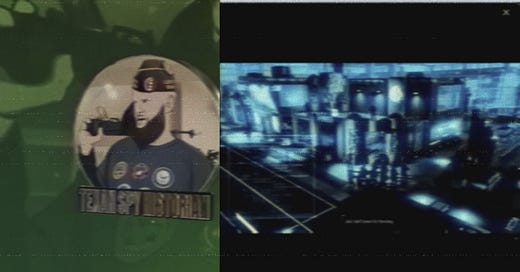In this narrative, we examine the nexus of Ukrainian nationalism and its collaboration with Nazi Germany during WWII, followed by the post-war integration of these groups into U.S. intelligence operations. We'll dissect how these events reflect both Sun Tzu's ancient espionage principles and the modern "Five Eyes of Spies" tactics. This exploration aims to illuminate how these historical intelligence maneuvers have significantly impacted Cold War strategies, providing insights into the enduring influence of espionage on global politics.
Throughout World War II, many Ukrainians, including a significant faction of the political class and a large portion of the civilian population, were sympathetic to Nazi Germany. Many of these sympathizers were also ardent Ukrainian nationalists, focused on establishing and strengthening Ukrainian nationhood, promoting what they viewed as authentic Ukrainian culture.
The Five Eyes of Spies tactics were notably employed in this context:
Infiltrate: Ukrainian nationalists found themselves in the U.S.-occupied zone of Germany post-war, a scenario not entirely coincidental, suggesting intelligence operations to infiltrate these groups, much like Sun Tzu's advice on employing local spies to gain knowledge from the inhabitants of a district.
Imitate Rhetoric: By adopting the nationalist rhetoric and collaborating with groups like the OUN, Nazi Germany gained trust and influenced these factions, akin to using inward spies, officials from the enemy, to gather information.
Instigate Division: The OUN's actions, particularly against Poles and Jews, often created or deepen divisions, facilitating control or manipulation by external forces, resonating with Sun Tzu's concept of converted spies who are manipulated to serve the opposite side.
Influence: Through propaganda and by aligning with nationalist sentiments, Nazi Germany and later the U.S. shaped the narrative around Ukrainian identity and resistance against Soviet influence, mirroring the use of spies for every kind of business as Sun Tzu suggests.
Isolate: By discrediting or isolating figures like Stepan Bandera, who was deemed "politically unacceptable" by the U.S., both allies and adversaries used this tactic to manipulate or control nationalist movements, similar to how Sun Tzu describes managing spies with subtlety and secrecy.
The debate on the historical existence of a Ukrainian nation-state before World War I aside, these nationalists, many of whom were Nazis or Nazi sympathizers, formed militias and fought alongside the Germans. The most prominent organization among these was the Organization of Ukrainian Nationalists (OUN), founded in 1929. During the war, the OUN established militias that primarily targeted Poles and Jews, contributing to a Holocaust in Ukraine that was even more severe than in Germany itself. Descendants from Jewish families in Odessa, Ukraine, witnessed this brutality firsthand.
Sun Tzu's "The Use Of Spies" principles were evidently at play:
Raising Armies and the Cost of War: The involvement in WWII, with its vast armies and resources, led to significant human and economic costs, much like what Sun Tzu warns about the drain on a state's resources.
The Importance of Foreknowledge: The OUN's collaboration with the Nazis and later with U.S. intelligence agencies underscores the critical role of foreknowledge in warfare, as emphasized by Sun Tzu. This knowledge was not derived from spirits or calculations but from human intelligence, or spies.
Types of Spies: The various engagements from local cooperation, turning enemy officials to using defectors or misinformation, align with Sun Tzu's five classes of spies.
Secrecy and Reward: The covert operations and the strategic use of individuals like Mykola Lebed for intelligence purposes reflect Sun Tzu's advice on the necessity of secrecy, liberal rewards, and the careful management of spies.
The End Aim: All these spy tactics aimed at understanding the enemy's disposition, which was crucial for both Nazi Germany's and later U.S. strategies in Ukraine.
Post-war, the U.S. Army's Counterintelligence Corps (CIC) began engaging with these Ukrainian nationalists. By 1947, the CIC was reporting on Mykola Lebed, described as a known sadist and Nazi collaborator, yet he was soon after used in intelligence operations, moved to Munich to collaborate with what would become the CIA, reflecting Sun Tzu's notion of employing converted spies.
In 1948, Project ICON began, involving airdrops to Lebed's group in Ukraine, later renamed Project Aerodynamic. This collaboration extended through the Cold War. However, Stepan Bandera, another OUN leader, was deemed too controversial by the U.S., leading him to work with British intelligence, a strategy akin to managing doomed spies to mislead the enemy.
Lebed relocated to New York City in 1948, with CIA Director Alan Dulles intervening in his asylum process, allowing entry in 1952, showcasing the strategic use of surviving spies for long-term intelligence benefits.
Concurrently, in 1949, NATO was founded to counter Soviet expansion, utilizing intelligence and manipulation tactics reminiscent of Sun Tzu's teachings on the strategic use of spies in warfare.
CONCLUSION
During WWII, Ukrainian nationalists, including the OUN, collaborated with Nazi Germany to promote Ukrainian statehood, resulting in severe atrocities against Poles and Jews. Post-war, the U.S. engaged with these nationalists, notably through the CIC and later the CIA, employing figures like Mykola Lebed in intelligence operations, echoing Sun Tzu's espionage strategies. This involvement included tactics like infiltration, division, and misinformation, reminiscent of both ancient and modern spycraft. These efforts were part of a broader Cold War strategy against Soviet influence, culminating in projects like ICON and Aerodynamic. The narrative illustrates how historical espionage tactics continue to influence contemporary geopolitical maneuvers.













Share this post